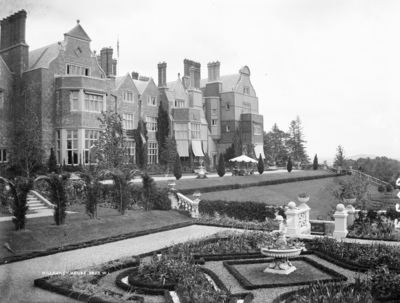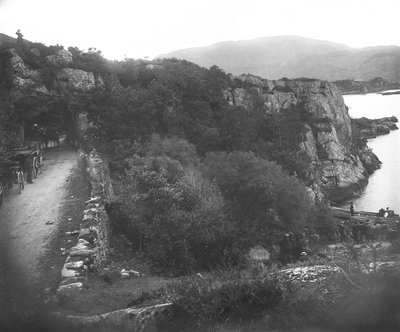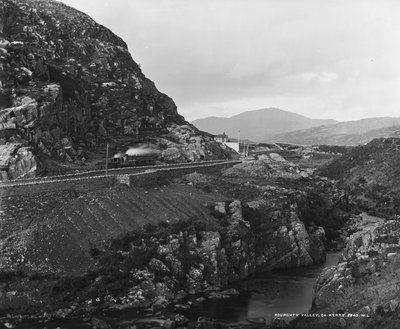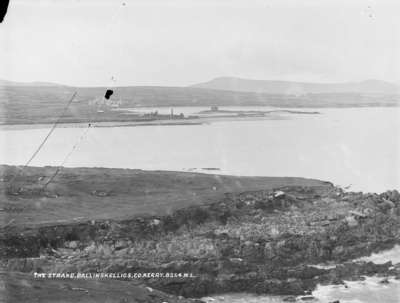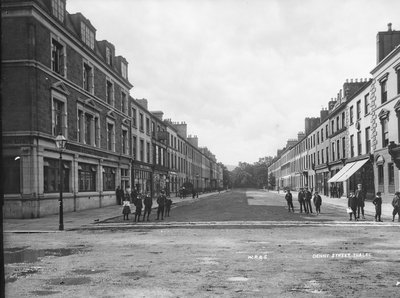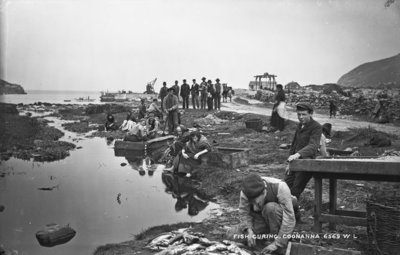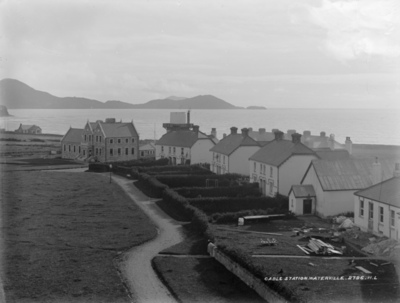Social conditions in Kerry in the early 20th century
View the photo galleryBy 1911 Kerry had already emerged as the most important tourist location in the country. Local landowners such as the Earls of Kenmare and the Herbert family in Muckross did much to foster the development of tourism in the county. Tourists were drawn first to the lakes around Killarney, a town which had emerged in the eighteenth century as a tourist destination. Nineteenth century travel writers had extolled the beauty of the town and its surrounding areas, and a further boost came with the arrival of the railway in 1853 (see household full of railway employees at Nelson Street, Tralee). The Great Southern Hotel opened the following year, and the town was filled with hotels, guesthouses and pubs. As early as 1865 Killarney had rooms to accommodate 500 visitors and, by then, Queen Victoria had already visited the area.
Killarney was the start and end point for the 100-mile trail through the main towns and villages of the Iveragh Peninsula, which was marketed for tourism as the ‘Ring of Kerry’, a spectacular coastal run through high mountains and through towns and villages such as Sneem, Kenmare (Kenmare Hotel) and Waterville (hotel in Waterville). The most spectacular site lay off the coast in the Atlantic Ocean. The ancient settlement of Sceilg Mhichíl, an island monastery of huts, oratories and decorated stones culminated in a remarkable hermit’s oratory on the south peak.
Further afield in the Dingle peninsula, spectacular scenery of glaciated mountains and sea cliffs framed a culture where Irish remained the language of the people (like the Moriarty family in Ballyferriter) , and a rich heritage included numerous monastic sites. These included Gallarus Oratory (a remarkable curved stone place of pilgrimage on the Saints’ Road up to Mount Brandon) and hundreds of beehive huts, known as clocháns.
The beaches of the county, from Inch Strand to Ballybunion, were also a huge draw for tourists, many of whom were English. It was well into the twentieth century before American tourists came in large numbers to Kerry. Many subsidiary industries grew up around tourism (see George Beatson, a pastry cook from Scotland living in Tralee), including that of guides, who took the mostly British tourists to the various sites. There was even a fledgling photographic industry in Killarney established by Louis Anthony , who was born in Italy, but established a photographic business on the High Street in Killarney producing postcards.
For all that the tourist industry brought some employment to Kerry, visitors who wrote about their stay in the county noted the number of people who were begging. There was no escaping the poverty in a county where the workhouse was filled with suffering paupers. The poverty of Kerry was evident everywhere. It was evident in the number of families who lost children early in life (see Pat Murphy, farmer in Fenit); it was evident in low levels of life expectancy (see the number of children the Curranes lost); and it was evident in the numbers who left the county never to return.
Emigration brought its own grief, but staying at home on the farm often meant a precarious as well as a thankless existence. Women usually worked at home on the family farm without pay (see the Hallissey family in Sneem), or for very low wages for larger farmers ( see Kelly family in Fenit] . The majority of farms in the county were basic subsistence units of under 20 acres in size. There were still large estates, for example, Muckross House built in 1843 on the eastern shore of Muckross Lake, and land agents (see John Leonard, land agent, Listowel) but the bulk of the land of the county was now owned by local tenant farmers ( see Patrick Dineen, Ballinclogher).
Kerry had been prominent in the Land War of 1879-1882 and in the Plan of Campaign in the second part of the 1880s. The chairman of the Tralee branch of the Land League was Timothy Harrington, editor of the Kerry Sentinel (see Patrick J. O’Connell, a reporter living in Blackpool in Tralee) which he had founded with his brother Edward. During the 1880s, Kerry had been the scene of numerous evictions and land-related violence, including murder. Owning the land had not ensured prosperity, nor had it necessarily brought insulation from old perils. Not everyone in the county had enough to eat. For example, an inquest into the death of Kerry fisherman Joseph Griffen in the late 1890s had noted that his demise had been accelerated by hunger.
The coastline of Kerry allowed a certain economic activity, through ships sailing into its harbours ( see Christian Erikson, Danish skipper of boat at Dingle) and through fishing (see Daniel Guerin at Milltown]. Cattle were exported on the hoof (Dan Crowley was a dock labourer at Fenit) from the port at Fenit overseen by the coastguard, Thomas Cook, and all across the county farming was the mainstay of the economy (see the Doody family in Kilcummin). Generations of the same family lived under the one roof and worked on the land (see the Hicksons at Kinard in West Kerry). Along the coast, farming and fishing went hand-in-glove, with many seeking to combine both activities to earn a living (see Michael Baker, Gallarus, West Kerry).
Towns such as Listowel and Kenmare and Castleisland did enjoy a certain prosperity and part of this prosperity was rooted in agriculture, such as the presence of blacksmiths (see John Leonard, Main Street, Castleisland) Beyond agriculture-related industry, there were telgraphists (Daniel Herbert, Spukane, Co. Kerry), coachbuilders (William Stack, Steepleview, Tralee), watchmakers (James Butler, John Street, Dingle) and shoemakers (Michael Kelliher, Blackpool, Tralee). There was also the usual collection of shopkeepers (Thomas Cronin, 62 William Street, Listowel), tailors (Ferriters of Dingle) and publicans (Corkery family publicans and grocers in Brandon). There was also limited industry (George Hickson, engineer, Ballyegan, East Kerry) and employment in services (Maurice Kelliher, hairdresser, Tralee). The cable-company on Valentia Island drew in highly-skilled operators who sent and received messages between Europe and America (See Bona family at Waterville). For example, there had been limited mining for copper in the county, at Ross Island, and the Ross Island Mining Company tried to re-establish the industry in 1911-12, but to no avail.
And the towns of Kerry, just as was the case all across Ireland, also had industrial schools. There was an industrial school for girls and for boys under the age of 10 in Killarney which was managed by the Sisters of Mercy. In 1911 there were 88 girls and 27 boys domiciled there. Many were from Kerrry, but there were also many from the rest of Munster and even from as far afield as Dublin. There was another industrial school on Pembroke Street in Tralee. At another industrial school in Kenmare run by the Poor Clare nuns, lace-making was introduced in the 1860s. The lace made was famous at home and abroad, and the industry survived until the outbreak of World War I.

